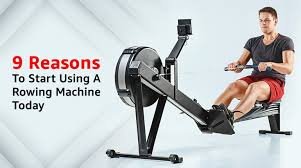
Rowing Machine Benefits: Full Guide to Strength, Cardio, and Weight Loss Advantages
Introduction to Rowing Machines
The rowing machine, also known as an indoor rower or ergometer, is rapidly becoming one of the most popular fitness tools in gyms and home setups. Originally developed for competitive rowing athletes, it is now recognized as a full-body workout machine that benefits users of all ages and fitness levels. Whether you’re looking to burn fat, build endurance, or increase strength, the rowing machine offers a low-impact yet incredibly effective training option.
In this article, we’ll explore the top benefits of rowing machines, breaking down how this powerful piece of equipment improves your health, fitness, and overall well-being.
Full-Body Workout with One Movement
One of the most unique aspects of the rowing machine is that it provides a true full-body workout. Unlike treadmills or stationary bikes that primarily target the lower body, rowing engages 86% of the body’s muscles in a single stroke.
Muscles Worked:
- Legs (quads, hamstrings, calves)
- Glutes
- Back (lats, rhomboids, traps)
- Core (abs, obliques, lower back)
- Arms (biceps and triceps)
- Shoulders
Each stroke starts with a powerful leg drive, followed by core engagement and a strong upper-body pull, making it one of the most efficient compound movements in fitness. According to the American Fitness Professionals Association, this total-body motion boosts calorie burn and muscle tone.
Excellent Cardiovascular Conditioning
If you’re seeking to improve your heart health, lung capacity, and overall stamina, rowing is among the most effective cardio workouts available. It increases your VO2 max (your body’s ability to use oxygen), which is a critical indicator of cardiovascular fitness.
Regular rowing sessions can help:
- Lower resting heart rate
- Improve blood circulation
- Increase lung capacity
- Reduce the risk of heart disease and hypertension
The consistent rhythmic motion also provides a meditative effect, helping reduce stress while enhancing physical conditioning.
Effective for Weight Loss and Fat Burning
Looking to shed pounds? Rowing torches calories without over-stressing your joints. Depending on your weight and intensity, a 30-minute rowing session can burn between 250 to 600+ calories.
Here’s how rowing promotes weight loss:
- Combines aerobic and anaerobic exercise
- Engages large muscle groups, increasing metabolic demand
- Supports the afterburn effect (calories burned after the workout)
- Helps preserve lean muscle mass while losing fat
According to Harvard Medical School, rowing burns more calories than most common gym machines, making it a great option for efficient fat loss.
Low-Impact Yet High-Intensity
Unlike running or plyometric exercises, rowing is gentle on the joints while still offering high-intensity results. The seated position reduces stress on the knees, hips, and ankles, making rowing ideal for people recovering from injuries or with joint pain.
It’s especially beneficial for:
- Older adults
- Overweight individuals
- People with knee or ankle injuries
- Those looking for low-impact cross-training
Despite being low-impact, rowing can be used for HIIT (high-intensity interval training), offering a challenging and sweat-inducing workout without the strain of jumping or pounding the pavement.
Builds Muscular Strength and Endurance
Rowing isn’t just cardio—it’s also resistance training. Each stroke requires force against resistance, building both strength and muscular endurance over time.
Key benefits include:
- Increased back and shoulder strength
- Stronger legs and glutes
- Improved core stability
- Better grip strength and forearm endurance
This dual benefit of cardio + resistance helps improve overall athletic performance, posture, and day-to-day physical function.
Boosts Mental Health and Focus
Like many forms of aerobic activity, rowing helps release endorphins, often called the “feel-good” hormones. These natural mood boosters can help reduce symptoms of depression, anxiety, and chronic stress.
Additional mental benefits:
- Enhances concentration and focus
- Provides a meditative, rhythmic experience
- Supports better sleep quality
- Improves overall cognitive health
Especially when rowing in quiet settings or using immersive apps with scenic routes, it becomes a calming, mentally rejuvenating form of exercise.
Convenient for Home and Gym Use
One of the rowing machine’s biggest advantages is its versatility and accessibility. It fits seamlessly into both gym environments and home workout routines, requiring relatively little space compared to treadmills or ellipticals.
Modern rowing machines include features such as:
- Adjustable resistance for all fitness levels
- Built-in performance monitors (tracking distance, calories, watts, strokes/min)
- Foldable frames for easy storage
- Integration with fitness apps like Hydrow or Concept2
It’s an all-in-one tool for those with limited time and space.
Supports Better Posture and Spinal Health
Rowing promotes correct spinal alignment, encouraging you to sit tall, engage your core, and avoid slouching. When performed with good form, it strengthens the erector spinae and upper back muscles, which are key for maintaining a healthy posture.
Long-term benefits include:
- Reduced lower back pain
- Improved shoulder alignment
- Enhanced core stability
- Better functional movement in daily activities
Correct rowing form is essential, however. Beginners should consider watching tutorials or consulting with a coach to avoid injury.
Suitable for All Fitness Levels
Whether you’re a complete beginner, an athlete in training, or a rehabilitating patient, rowing can be tailored to your current ability. It allows you to:
- Adjust intensity easily (go slower or faster)
- Increase or decrease resistance
- Focus on endurance, strength, or interval training
- Scale workouts without high risk of injury
This makes the rowing machine a favorite among personal trainers, physical therapists, and fitness programs worldwide.
Trackable Progress and Measurable Results
Another big benefit of rowing is that it’s quantifiable. Most machines come with a PM (Performance Monitor) that tracks:
- Time
- Distance rowed
- Calories burned
- Strokes per minute (SPM)
- Split time (time per 500m)
This makes it easy to set goals, monitor improvements, and stay motivated over time. Many users find it satisfying to beat their personal bests or join online rowing challenges.
Ideal for Cross-Training and Athletic Conditioning
Rowing is an excellent addition to a well-rounded training program. It complements other sports like:
- Running
- Cycling
- Swimming
- Weightlifting
- Martial arts
Athletes use rowing for aerobic base building, active recovery, and mobility work. Because it’s low-impact and targets so many muscles, it enhances overall performance and helps prevent overuse injuries from repetitive motions.
Environmental and Cost Efficiency
Rowing machines require no electricity, making them both eco-friendly and cost-effective in the long run. Once purchased, there’s no monthly cost, no need for fuel or power, and minimal maintenance (especially for air or magnetic rowers).
Entry-level machines start at around $300, while top-tier models like the Concept2 Model D are considered gold-standard investments for serious users.
Conclusion: Why Rowing Machines Are Worth It
The rowing machine is more than just a cardio tool—it’s a full-body, high-efficiency fitness solution that can fit into almost any lifestyle or workout program. From building muscle endurance and burning fat, to improving mental focus and heart health, the benefits are as deep as the ocean it simulates.
Whether you’re an athlete, a weekend warrior, or someone simply looking to get fitter from home, investing in a rowing machine could be one of the smartest choices you make for your long-term health and physical transformation.






